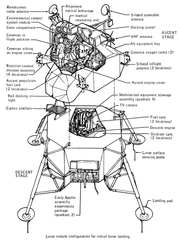
Back Apollo-maanmodule Afrikaans Apollo Lunar Module AN وحدة أبولو القمرية Arabic Apollon ay modulu Azerbaijani آپولو آیدا اوتورانی AZB Лунен модул Bulgarian অ্যাপোলো লুনার মডিউল Bengali/Bangla Modul-loar Apollo Breton Mòdul lunar Apollo Catalan مانگنشینی ئەپۆڵۆ CKB
 Apollo 16 LM Orion on the lunar surface | |
| Manufacturer | Grumman Aircraft |
|---|---|
| Designer | Thomas J. Kelly |
| Country of origin | United States |
| Operator | NASA |
| Applications | Manned lunar landing |
| Specifications | |
| Design life | 75 hours (Extended) |
| Launch mass |
|
| Dry mass |
|
| Crew capacity | 2 |
| Dimensions | 23 feet 1 inch (7.04 m) high 31 feet (9.4 m) wide 31 feet (9.4 m) deep overall, landing gear deployed |
| Volume | 235 cubic feet (6.7 m3) |
| Power | Batteries |
| Regime | Lunar |
| Production | |
| Status | Retired |
| Built | 15 |
| Launched | 10 |
| Operational | 10 |
| Failed | 0 |
| Lost | 0 |
| First launch | January 22, 1968 |
| Last launch | December 14, 1972 |
| Last retirement | December 15, 1972 |
  Apollo LM diagram | |

The Apollo Lunar Module (LM) is the spidery-looking landing vehicle on the moon. It was built for the US Apollo program to carry a crew of two from lunar orbit to the surface and back.
The LM was the last of the Apollo “hardware” to be developed. Its start had been delayed while NASA made up its mind to take the lunar-orbit meeting approach and thus require a vehicle like the LM for a landing. A contract with the prime builder was signed on January, 1963, almost two years after the Apollo project began. The LM was tested several times in space.[1] Finally, on July 20, 1969 the Apollo 11 LM Eagle made the first manned lunar landing.
As Apollo missions progressed, Apollo 12, 14, 15, 16, 17 had lunar landings using their LMs. Apollo 13 had a terribly dangerous accident when an oxygen tank exploded. The Apollo 13 Lunar module, called Aquarius, played an unexpected role in saving the lives of the three astronauts after the explosion.[2]
- ↑ Moon Race: The History of Apollo DVD, Columbia River Entertainment (Portland, Oregon, 2007)
- ↑ Cass, Stephen (April 1, 2005). "Houston, we have a solution". IEEE. Retrieved August 30, 2019.